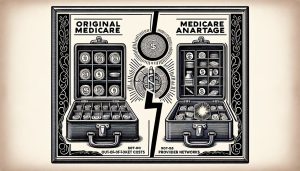Medicare Supplement Plans 2025
When it comes to Medigap insurance, it can be a bit overwhelming with all the different choices available. This article will easily break down the top Medicare Supplement Plans for 2025 to help you make an informed decision.
This article cuts through the complexity, offering straightforward guidance on Original Medicare, Medicare Advantage, and Medigap—without the fluff.
Get ready to gain insight into not only the benefits and differences of each option but also the enrollment process and the financial considerations at play. Start your journey to a well-informed Medicare insurance decision here.
Key Takeaways
- Medicare provides health coverage for over 65 million individuals in the United States, including seniors 65 or older and younger people with certain disabilities, offering various parts such as Hospital Insurance (Part A) and Medical Insurance (Part B).
- Enrollment in Medicare features specific periods such as the Initial Enrollment Period, which surrounds an individual’s 65th birthday, and Special Enrollment Periods for qualifying life events, both critical for avoiding penalties and ensuring timely coverage.
- Medicare beneficiaries can choose between Original Medicare and Medicare Advantage Plans, while also considering add-on options like Medicare Prescription Drug Coverage (Part D) and Medicare Supplement Insurance (Medigap) to fill coverage gaps.
The Best Medicare Supplement Plans for 2025
- Medicare Plan G
- Medicare Plan N
- High-deductible Plan G
- Medicare Plan F*
*only those enrolled in Medicare prior to January 1st of 2020 may enroll in a Medicare Plan F
 Medicare Plan N 2025
Medicare Plan N 2025
As we step into 2025, Medicare Plan N emerges as a compelling option for beneficiaries seeking affordable coverage without sacrificing essential benefits. This plan offers a balanced mix of coverage and cost-effectiveness, making it an attractive choice for individuals navigating their healthcare needs.
Medicare Plan N provides coverage for Medicare Part A coinsurance and hospital costs, along with coverage for Medicare Part B coinsurance or copayments. While it may require beneficiaries to share some out-of-pocket costs, such as copayments for certain doctor visits and emergency room visits, the overall coverage remains comprehensive.
Additionally, Plan N includes coverage for skilled nursing facility care coinsurance and even some of the expenses related to foreign travel emergencies, offering peace of mind for travelers.
One of the notable features of Medicare Plan N is its affordability. With lower premiums compared to some other Medicare plans, Plan N appeals to beneficiaries looking to manage their healthcare expenses effectively.
While there may be some cost-sharing requirements, such as copayments for certain services, the overall affordability of Plan N can lead to significant savings over time.
Looking ahead to 2025, Medicare Plan N is expected to continue its reputation as a reliable and cost-effective option for Medicare beneficiaries.
As healthcare needs evolve, the affordability and comprehensive benefits offered by Plan N will remain essential for individuals seeking reliable coverage without breaking the bank.
In summary, Medicare Plan N in 2025 provides affordable coverage with comprehensive benefits, including coverage for hospital costs, doctor visits, and emergency care. Beneficiaries can trust in the affordability and reliability of Plan N as they navigate their healthcare journey in the years to come.
 Medicare Plan F 2025
Medicare Plan F 2025
In the landscape of Medicare plans for 2025, Medicare Plan F stands out as a steadfast option, offering comprehensive coverage and peace of mind for beneficiaries. This plan continues to provide extensive benefits, making it a popular choice among those seeking comprehensive healthcare coverage.
Medicare Plan F covers all Medicare deductibles, coinsurance, and copayments, leaving beneficiaries with minimal out-of-pocket expenses for covered services.
With comprehensive coverage for Medicare Part A and B deductibles, as well as coinsurance for hospital and medical services, Plan F ensures that beneficiaries can access the care they need without the burden of significant financial barriers.
One of the key advantages of Medicare Plan F is its simplicity. With this plan, beneficiaries do not have to worry about navigating complex cost-sharing structures or unexpected out-of-pocket costs.
Instead, they can enjoy the convenience of knowing that most of their healthcare expenses are covered, providing peace of mind and financial predictability.
Looking ahead to 2025, Medicare Plan F remains a reliable option for beneficiaries seeking comprehensive coverage and stability in their healthcare choices. While this plan is no longer available to newly eligible Medicare beneficiaries as of 2020, those who enrolled prior to that date can continue to enjoy its benefits.
In summary, Medicare Plan F in 2025 offers comprehensive coverage, simplicity, and peace of mind for beneficiaries. With extensive benefits and minimal out-of-pocket expenses, Plan F remains a steadfast choice for individuals navigating their healthcare needs with confidence and security.
High-deductible Medicare Plan G
In the realm of Medicare options, High-Deductible Medicare Plan G emerges as a unique choice for beneficiaries looking to strike a balance between affordability and comprehensive coverage in 2025. This plan offers an alternative approach to traditional Medicare plans, catering to individuals who are willing to manage higher deductibles in exchange for lower premiums.
High-Deductible Medicare Plan G operates similarly to standard Plan G, providing coverage for Medicare Part A and B coinsurance, hospital costs, and even hospice care coinsurance or copayments. However, what sets it apart is the higher deductible requirement that beneficiaries must meet before the plan begins to cover expenses.
Despite the higher deductible, High-Deductible Medicare Plan G offers significant advantages. By opting for this plan, beneficiaries can enjoy lower monthly premiums, making it a cost-effective option for those who are in good health or have the financial means to cover higher out-of-pocket costs when necessary.
Additionally, High-Deductible Medicare Plan G still provides the comprehensive coverage and flexibility in healthcare provider choice that beneficiaries expect from a Medicare plan.
With no network restrictions, individuals can access care from their preferred doctors and hospitals, ensuring continuity of care and personalized treatment options.
As we look ahead to 2025, High-Deductible Medicare Plan G continues to offer a viable solution for beneficiaries seeking affordability without sacrificing coverage.
While it may not be the best fit for everyone, it provides an alternative for those who are willing to manage higher deductibles in exchange for lower premiums and comprehensive benefits.
In summary, High-Deductible Medicare Plan G in 2025 presents a balanced approach to healthcare coverage, offering affordability and comprehensive benefits. Beneficiaries can explore this option as they navigate their healthcare needs, considering its potential for cost savings and flexibility in provider choice.
Understanding Medicare: The Basics of Health Coverage for Seniors

Medicare, a cornerstone of health security in the United States, offers a safety net for those who’ve woven the fabric of this nation—our seniors. But it’s not just for those who’ve celebrated their 65th revolution around the sun; it’s also for younger individuals grappling with specific disabilities or diseases.
Funded through a tapestry of payroll taxes, premiums, and federal budget allocations, Medicare stands as a testament to a society’s commitment to its elders and vulnerable populations.
Picture it as an essential cog in the machine of retirement planning, a mechanism that eases the financial burden of health care, which can otherwise weigh heavy on the pockets of private insurance.
It’s a program that doesn’t waver with the winds of income levels, offering the same steadfast coverage to all eligible Americans. Now, let’s delve into the numbers and nuances of this vital program.
Medicare Enrollment Numbers
Over 65 million souls look to Medicare for health coverage, a number that speaks volumes about its significance. It’s a number that’s split between those opting for the original blueprint of Medicare and those who choose to augment it with Medicare Advantage plans.
And let’s not overlook the staggering 51 million who also seek prescription drug plans, a testament to the necessity of medication in maintaining the health of a nation.
This enrollment panorama paints a portrait of Medicare’s expansive reach, a comforting embrace for many in their later chapters of life. As we explore further, it becomes clear that Medicare is not just a program but a lifeline for a diverse mix of individuals.
The Different Parts of Medicare
Medicare unfurls itself in four parts, each a petal of the healthcare flower. Part A, the Hospital Insurance, ensures that hospital stays don’t turn into financial dismay.
It covers the bed you lie in, the care you receive, and the support you need when you’re most vulnerable. Then there’s Part B, the Medical Insurance, taking under its wing doctor’s visits, the outpatient care you require, and preventive services to keep you thriving, not just surviving.
But the bouquet grows fuller with Part C, the Medicare Advantage, an alternative cultivated by private insurers that often weaves in prescription drug coverage and additional benefits like dental, vision, and hearing care—a true cornucopia of care.
And Part D, the Prescription Drug Coverage, completes the arrangement, offering a lifeline of medications through private insurance providers.
Navigating the Medicare Enrollment Process

Enrolling in Medicare is akin to mapping a journey—you need to know the landmarks and the best times to travel. As you approach the golden age of 65 or if you’re in your 25th month of disability benefits, the government sends out a welcome package, a compass to guide you.
It includes your Medicare card, symbolizing the start of a new chapter in healthcare.
But tread carefully, the path is not the same for all. For those with fewer quarters of employment covered by Medicare, the road might come with a premium, a reminder that the underwriting process of life’s journey requires careful financial planning based on one’s employment status.
If you’re not automatically enrolled, you must reach out to Social Security, whether online, by phone, or in person, to embark on this voyage.
Initial Enrollment Period
Imagine the Initial Enrollment Period as a window that opens three months before you turn 65 and gently closes three months after. It’s a critical time when the decisions you make set the course for when your coverage will kick in.
Miss this window, and you might be left out in the cold, waiting for coverage when you need it most.
If you sign up before your 65th birthday, your coverage could start as early as the same month you don your birthday hat. But delay, and your coverage might lag, starting only in the following month or later.
And if you’re already receiving Social Security benefits, you’ll find yourself automatically enrolled, a seamless transition into the safety net of Medicare.
Special Enrollment Periods
Life’s tapestry is woven with unexpected threads, and sometimes, you might miss the Initial Enrollment Period. But don’t fret; Special Enrollment Periods are like hidden tunnels that allow you to enroll in Medicare without the sting of late penalties.
These are reserved for moments when the unexpected happens, such as losing employment-based coverage or becoming eligible for Medicaid.
These periods are a safety net, ensuring that unforeseen life changes don’t leave you without healthcare coverage.
However, if you don’t act within these golden eight months, you might face penalties or delays. But act swiftly, and you can secure coverage that starts promptly, ensuring that you’re never left without the care you need.
Comparing Medicare Advantage Plans vs. Original Medicare

When weighing Medicare Advantage against Original Medicare, think of it as a balance between certainty and flexibility. Medicare Advantage plans offer a predictable cap on out-of-pocket costs, a safeguard against financial storms.
On the other side of the scale, Original Medicare doesn’t tether you to a network of providers, allowing the freedom to choose any doctor who accepts Medicare, without the need for referrals.
Yet, Medicare Advantage plans might include additional benefits, akin to a treasure chest of services beyond the basic coverage of Original Medicare. It’s a decision that requires careful consideration of your health needs, lifestyle, and financial situation.
Let’s now look into one of the most critical aspects of both plans: prescription drug coverage.
Understanding Medicare Prescription Drug Coverage (Part D)

Prescription drug coverage under Medicare is offered through Part D, a beacon for those navigating the waters of medication expenses. It’s a voluntary program, with plans crafted by private insurers that stand by the government’s side to offer a spectrum of drug benefits.
Beneficiaries can find solace in the cost savings provided by these plans, whether through home delivery options or the choice of generic medications.
The Inflation Reduction Act has reshaped the landscape of Part D, capping insulin costs and placing a ceiling on out-of-pocket expenses, ensuring that beneficiaries don’t drown in a sea of medication expenses. With coverage phases that guide you from deductible to catastrophic coverage, Part D is structured to support you at every turn.
Medicare Supplement Insurance (Medigap) Explained

Imagine Medigap as the puzzle piece that fits perfectly into the Medicare picture, filling in the financial gaps left behind. These supplement insurance policies come in standardized plans, each identified by a letter, offering a different constellation of benefits to complement your Medicare coverage.
Whether it’s:
- Plan A’s basic benefits
- Plan B’s additional benefits
- Plan C’s comprehensive coverage
- Plan D’s prescription drug coverage
- Plan F’s full coverage
- Plan G’s high-deductible option
- Plan K’s cost-sharing benefits
- Plan L’s cost-sharing benefits
- Plan M’s cost-sharing benefits
- Plan N’s extensive coverage, including foreign travel emergencies
There’s a Medigap policy for every need.
While some plans, like the sought-after C and F, have sailed into the sunset for new enrollees, other high-deductible options beckon to those who prefer a balance of lower premiums and higher out-of-pocket costs.
It’s the nuances in coverage and costs that make Medigap a critical piece of the Medicare mosaic.
Choosing a Medigap Policy
Selecting the right Medigap insurance policy is a process akin to choosing the perfect outfit—it must fit your lifestyle and financial situation.
With various plans offered by different insurers, it’s a sartorial decision that requires an eye for detail. The benefits might be consistent across policies with the same letter designation, but the price tag attached can vary.
How Medigap Works with Medicare
Medigap policies work in tandem with Medicare, stepping in like a trusted friend to cover the remaining costs after Medicare has paid its share. It’s a partnership that ensures you’re not left handling 100% of your healthcare costs alone.
For couples, this means two separate policies because, just like dancing, healthcare coverage is a step that each must take on their own in the business of life.
The Financial Aspect of Medicare
The financial aspect of Medicare is more than just a line item on a budget; it’s a crucial component of personal finance for millions. With Part C plans’ payment costs ebbing and flowing based on various factors, and out-of-pocket expenses steadily climbing, it’s a landscape that requires navigation with a keen eye on cash flow and the market.
The projected spending on Part D alone is a whopping $120 billion, a figure that underscores the importance of understanding the financial implications of Medicare.
Analyzing Your Medicare Costs
To truly assess your Medicare expenses, you must examine the full spectrum—from premiums to the frequency of healthcare services used. High-income beneficiaries find their premiums adjusted, a balance that’s maintained even as the income scales tip.
Medicare Savings Programs and the Low-Income Subsidy offer financial assistance, a buoy for those drowning in healthcare costs, with bottom-line underwriting playing a role in the process, as loan officers might do in a personal loans context for a lender.
Medicare Services Beyond Basic Coverage
Medicare extends its reach beyond the basics, weaving a safety net that includes preventive care, home health care, and hospice care. These services are often offered at little to no cost to beneficiaries, ensuring that health isn’t a luxury but a right.
Hospice care, in particular, stands as a pillar of compassion, offering support not just to the terminally ill but also to their families, with minimal financial burden.
Maximizing Your Medicare Benefits
To maximize your Medicare benefits, it’s crucial to review your current or former employer or union drug coverage plans. This appraisal process can unveil whether it’s more profitable to stick with your existing plan or switch to a Medicare drug coverage option.
It’s a decision that can significantly affect your life and savings, one that should be made with all the facts in hand.
Medicare Supplement Plans Comparison Chart
Summary
As we reach the end of our comprehensive exploration of Medicare Supplement Plans for 2025, we hope you feel empowered with knowledge.
From understanding the various parts of Medicare to navigating the enrollment process, comparing coverage options, and planning for the financial aspects, you are now equipped to make choices that align with your health needs and financial situation.
Frequently Asked Questions
→ What is the Medicare health insurance?
Medicare is a federal health insurance program for individuals aged 65 or older, as well as some younger people with disabilities or end-stage renal disease. It provides coverage for a range of medical services and treatments.
→ What are the 3 types of Medicare?
Medicare consists of four parts: Part A for inpatient/hospital coverage, Part B for outpatient/medical coverage, Part C for an alternative way to receive benefits, and Part D for prescription drug coverage. Each part covers specific services to meet various healthcare needs.
→ What is the main difference between Medicare Advantage and Original Medicare?
The main difference between Medicare Advantage and Original Medicare is that Medicare Advantage plans have an annual limit on out-of-pocket costs and may include extra benefits, but require using a network of doctors, while Original Medicare has no annual cap on costs and allows visits to any doctor that accepts Medicare without needing referrals.
→ Can I enroll in Medicare Part D if I have other prescription drug coverage?
Yes, you can enroll in Medicare Part D even if you have other prescription drug coverage, but it’s important to compare the two to determine which is more beneficial and keep documentation if your other coverage is creditable.
→ Are Medigap policies available to both me and my spouse?
No, Medigap policies are only available for individuals, so both you and your spouse would need to have separate policies.
The easiest way to get started is to call us today at 1-888-891-0229.
We’ll answer all of your questions and help you find the right Medicare plan. Or you can use our FREE quote engine to begin shopping today!

States:
Updated March 25th, 2024


 Medicare Plan G 2025
Medicare Plan G 2025 Medicare Plan N 2025
Medicare Plan N 2025 Medicare Plan F 2025
Medicare Plan F 2025